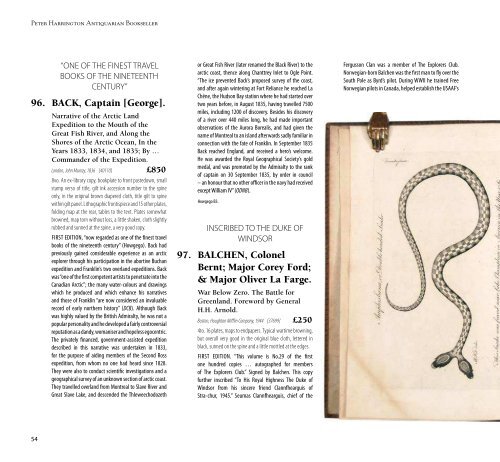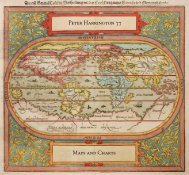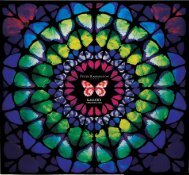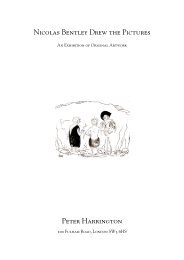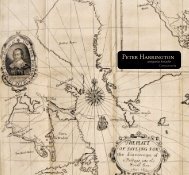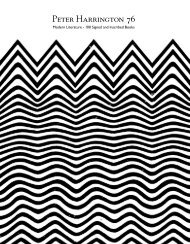antiquarian bookseller - Peter Harrington
antiquarian bookseller - Peter Harrington
antiquarian bookseller - Peter Harrington
Create successful ePaper yourself
Turn your PDF publications into a flip-book with our unique Google optimized e-Paper software.
<strong>Peter</strong> <strong>Harrington</strong> Antiquarian Bookseller<br />
“ONE OF THE FINEST TRAVEL<br />
BOOKS OF THE NINETEENTH<br />
CENTURY”<br />
96. BACK, Captain [George].<br />
Narrative of the Arctic Land<br />
Expedition to the Mouth of the<br />
Great Fish River, and Along the<br />
Shores of the Arctic Ocean, In the<br />
Years 1833, 1834, and 1835; By …<br />
Commander of the Expedition.<br />
London, John Murray, 1836 [40110] £850<br />
8vo. An ex-library copy, bookplate to front pastedown, small<br />
stamp verso of title, gilt ink accession number to the spine<br />
only, in the original brown diapered cloth, title gilt to spine<br />
within gilt panel. Lithographic frontispiece and 15 other plates,<br />
folding map at the rear, tables to the text. Plates somewhat<br />
browned, map torn without loss, a little shaken, cloth slightly<br />
rubbed and sunned at the spine, a very good copy.<br />
FIRST EDITION, “now regarded as one of the finest travel<br />
books of the nineteenth century” (Howgego). Back had<br />
previously gained considerable experience as an arctic<br />
explorer through his participation in the abortive Buchan<br />
expedition and Franklin’s two overland expeditions. Back<br />
was “one of the first competent artists to penetrate into the<br />
Canadian Arctic”; the many water-colours and drawings<br />
which he produced and which enhance his narratives<br />
and those of Franklin “are now considered an invaluable<br />
record of early northern history” (DCB). Although Back<br />
was highly valued by the British Admiralty, he was not a<br />
popular personality and he developed a fairly controversial<br />
reputation as a dandy, womaniser and hopeless egocentric.<br />
The privately financed, government-assisted expedition<br />
described in this narrative was undertaken in 1833,<br />
for the purpose of aiding members of the Second Ross<br />
expedition, from whom no one had heard since 1828.<br />
They were also to conduct scientific investigations and a<br />
geographical survey of an unknown section of arctic coast.<br />
They travelled overland from Montreal to Slave River and<br />
Great Slave Lake, and descended the Thleweechodozeth<br />
or Great Fish River (later renamed the Black River) to the<br />
arctic coast, thence along Chanttrey Inlet to Ogle Point.<br />
“The ice prevented Back’s proposed survey of the coast,<br />
and after again wintering at Fort Reliance he reached La<br />
Chêne, the Hudson Bay station where he had started over<br />
two years before, in August 1835, having travelled 7500<br />
miles, including 1200 of discovery. Besides his discovery<br />
of a river over 440 miles long, he had made important<br />
observations of the Aurora Borealis, and had given the<br />
name of Montreal to an island afterwards sadly familiar in<br />
connection with the fate of Franklin. In September 1835<br />
Back reached England, and received a hero’s welcome.<br />
He was awarded the Royal Geographical Society’s gold<br />
medal, and was promoted by the Admiralty to the rank<br />
of captain on 30 September 1835, by order in council<br />
– an honour that no other officer in the navy had received<br />
except William IV” (ODNB).<br />
Howgego B3.<br />
INSCRIBED TO THE DUKE OF<br />
WINDSOR<br />
97. BALCHEN, Colonel<br />
Bernt; Major Corey Ford;<br />
& Major Oliver La Farge.<br />
War Below Zero. The Battle for<br />
Greenland. Foreword by General<br />
H.H. Arnold.<br />
Boston, Houghton Mifflin Company, 1944 [37699] £250<br />
4to. 16 plates, maps to endpapers. Typical wartime browning,<br />
but overall very good in the original blue cloth, lettered in<br />
black, sunned on the spine and a little mottled at the edges.<br />
FIRST EDITION. “This volume is No.29 of the first<br />
one hundred copies … autographed for members<br />
of The Explorers Club.” Signed by Balchen. This copy<br />
further inscribed “To His Royal Highness The Duke of<br />
Windsor from his sincere friend Clannfhearguis of<br />
Stra-chur, 1945.” Seumas Clannfhearguis, chief of the<br />
Fergusson Clan was a member of The Explorers Club.<br />
Norwegian-born Balchen was the first man to fly over the<br />
South Pole as Byrd’s pilot. During WWII he trained Free<br />
Norwegian pilots in Canada, helped establish the USAAF’s<br />
base at Qaanaaq in Greenland, worked in support of the<br />
Scandinavian Resistance organizations and organized the<br />
bombing of the sole German base on Greenland. Post-<br />
War he commanded the USAF’s 10th Rescue Squadron<br />
in Alaska.<br />
98. [BANCROFT, Edward]<br />
An Essay on the Natural History<br />
of Guiana, in South America.<br />
Containing a description of many<br />
curious productions in the animal<br />
and vegetable systems of that<br />
country. Together with an account of<br />
the religion, manners, and customs<br />
of several tribes of its Indian<br />
inhabitants. Interspersed with<br />
a variety of literary and medical<br />
observations. In Several Letters<br />
from A Gentleman of the Medical<br />
Faculty, During his Residence in<br />
that Country.<br />
London, for T. Becket and P. A. De Hondt, 1769 [32140] £1750<br />
8vo (212 × 130 mm). Contemporary sprinkled calf, black<br />
morocco label, spine gilt in compartments, sides with gilt<br />
border roll. Engraved frontispiece of a double-headed snake<br />
by M. Park. Armorial bookplate of Frederick Ponsonby, third<br />
earl of Bessborough (1758–1844); later Isercleran booklabel.<br />
Four small stains in upper margin of X3 and a few other leaves,<br />
upper joint a little tender, but a very handsome copy.<br />
FIRST EDITION. Edward Bancroft, “chemist and spy”<br />
(ODNB), was an American by birth but moved to England<br />
at the age of 23, where he spied for Franklin and then for<br />
the British. In the meantime he had spent some time in<br />
Dutch Guiana where he gathered the material for this,<br />
his first book. It is, in his own words, “an account of the<br />
unknown productions of an almost unknown country”.<br />
The first part is devoted to the flora of the country; the<br />
next to the fauna, in particular the snakes, with the<br />
remainder being a detailed description of the indigenous<br />
peoples and the local economy. He noted the transmission<br />
of yaws by flies (on p. 385).<br />
Garrison–Morton 5304.<br />
<strong>Peter</strong> <strong>Harrington</strong><br />
<strong>antiquarian</strong> <strong>bookseller</strong><br />
Catalogue 57: Travel<br />
Section 1:<br />
World Voyages & Compilations<br />
Items 1-22; pages 2-17<br />
Section 2:<br />
Africa and the Middle East to Persia<br />
Items 23-95; pages 18-53<br />
Section 3:<br />
The Americas, Greenland<br />
and the Arctic<br />
Items 96-141; pages 54-77<br />
Section 4:<br />
Asia including Russia<br />
Items 142-211; pages 78-105<br />
Section 5:<br />
Australia and Antarctica<br />
Items 212-232; pages 106-117<br />
Section 6:<br />
Europe, including Constantinople<br />
Items 233-276; pages 118-139<br />
Section 7:<br />
Mapping, Navigation and Naval<br />
History<br />
Items 277-331; pages 140-169<br />
Index; pages 170-171


